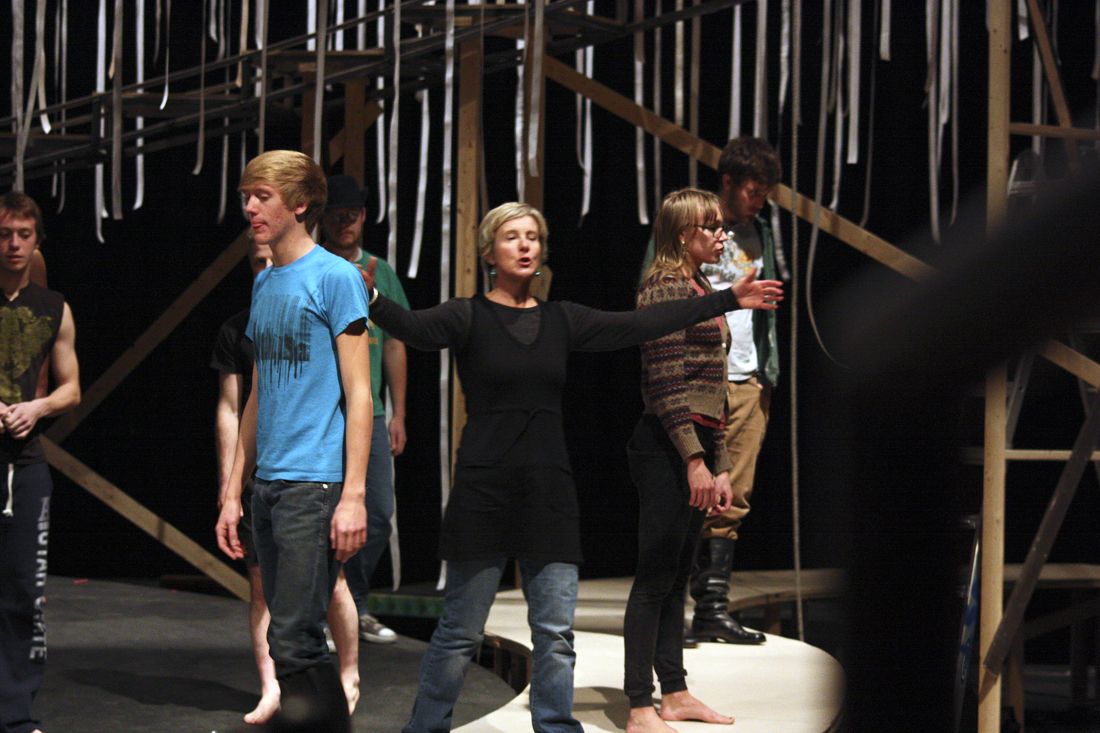Not your average Shakespeare play
“Forget all preconceived notions that Shakespeare is boring,” said Felicia Stehmeier, a senior majoring in theater. With a 65-piece orchestra playing Felix Mendelssohn’s score, and the USU Women’s Choir all onstage, this production is truly a collaborative effort of the Caine College of the Arts.
“We have worked pretty hard to make non-boring, vomit-less Shakespeare,” said Richie Call, a visiting assistant professor of theatre arts who is directing “A Midsummer Night’s Dream.”
Lance Rasmussen, a sophomore majoring in theatre who is playing Bottom in the play, said, “Shakespeare is meant to be seen onstage. There are things in the script that don’t make sense unless you act them.” Rasmussen said many people are deterred from enjoying Shakespeare because they’ve been exposed to it in school where it’s often presented as dry.
The play was cast in early October with 28 actors. Twenty are theatre majors, but there are five other USU students involved, as well as a 2-year-old, a community member and an associate professor. The audition itself involved some different aspects. Stehmeier said in addition to the standard monologues, there were six fairy pictures on display which the actors used as inspiration for a prepared, one-minute movement piece performed as part of the audition.
Call said this idea was Camille Litalien’s. Litalien is an assistant theatre professor who specializes in movement and dance and choreographed the show. Call said the movement pieces varied from actor to actor.
“Some were very ballet-y and some had no other dance experience,” Call said.
Litalien’s choreography emphasizes the movement of the fairy world in particular. There is rope dancing and gymnastics in addition to more dance-oriented fairy movement. Jackson Simmons, freshman theatre major playing a fairy, said he has more sound effects than lines.
“You are telling the story with your body,” Simmons said. He said this helps makes the play very understandable, even with the Shakespearean language.
“The play incorporates a lot of movement. You’re creating something,” said Jessica Jackson, a junior theater major, playing the fairy Moth. Because Jackson is not a dancer, she said working so closely with Litalien and the movement choreography has allowed her to explore movement more studiously.
The orchestra score makes this production of “Midsummer” a unique experience that is different than other productions of the play, Call said. The orchestra continues to play for several minutes after the dialogue ends, meaning the actors have to incorporate a visual.
“Who are Puck and Peaseblossom and Mustardseed? The music makes a great opportunity to showcase their fairy world.” Call said.
The fairy world is well represented in the set, said set designer Dennis Hassan, associate professor of scenic design and assistant department head.
Though the play is set in the time period of Mendelssohn’s score, the 1820s, and has period costumes, Hassan’s set focuses more on the fairy aspect, with a circular walkway onstage reminiscent of a fairy circle. However, the spiral staircase prominent across the stage does incorporate the early 19th century popularity for spiral staircases.
The stage has what is called a “unit set,” where it doesn’t change a lot in the course of the roughly two-hour play. Hassan’s design has opportunities for dramatic entrances, while still allowing the orchestra to be seen in the back, the conductor actually stands on the stage. A path winds through the orchestra, and the fairies interact with and respond to the orchestra, Hassan said.
“The thought was of weaving in and out of their fairy world. The queen comes down from above and the king comes up through the sand,” Hassan said. He considers the set a type of sculpture with abstract aspects.
Call said he thinks the music, the set, the costume and the cast have all combined to make this production the play that Shakespeare, one of the greatest writers in the world wrote. He said everyone involved has brought their own idea of what the world of the play is.
“My job is to rein all of them in to one world,” Call said.
Stehmeier said doing Shakespeare and working with Call has been a different experience than previous shows.
“He really pushes you,” Stehmeier said. The cast has held rehearsals five days a week, from 6:30-9:30, since early October. The orchestra has also been working on the score all semester.
Hassan also plays Oberon, king of the fairies. His wife, Wendy, plays the fairy queen Titania. As newly engaged students 20 years ago, they both appeared in a production of “Midsummer” here at USU.
“It’s a once in a lifetime opportunity to work with my wife in a play I love and with great parts,” Hassan said. Balancing the set design and construction, rehearsals, the two classes he teaches and family has made the schedule hectic but he said he has enjoyed it as well.
The play runs Dec. 8-11 at 7:30 p.m. in the Morgan Theatre. There is also an additional matinee at 2 p.m. on Dec. 11. Tickets are free for students with ID and $9-$13 for the public. They are available at the Box Office in the Chase Fine Arts Center or online.
– genevieve.draper@aggiemail.usu.edu

